Washington Samulnori
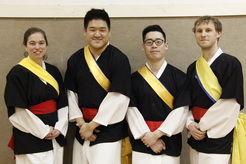
Washington Samulnori is a Korean traditional percussion performing troupe, dedicated to performing and preserving “Samulnori”. The Korean words “sa” and “mul” mean “four things” and “nori” means “to play.” In the case of SamulNori, it refers to the four musicians playing four different types of percussive instruments: the changgo (hourglass-shaped drum), the buk (barrel drum), the jing (large gong), and the kkwaenggwari (small gong). The origins of their music can be traced to farmers’ band music (“nong-ak”) and ceremonial music. The repertoire of SamulNori also integrates the influences of folk and religious music and their intricate rhythms have become quite uniquely their own.
Founded by Sebastian Wang, the group’s director, Washington Samulnori consists of local professional musicians who specialize in Samulnori. These members include Sanghyuk Park, Robin Ghertner, and Hyunseop Lee. Director Wang is a graduate of the Korean National University of Arts in Seoul, Korea. Among the many masters of Korean Traditional Arts he has studied with, the most well-known is Professor Kim Duk Soo, the founder and creator of Samulnori. Director Wang hopes to promote and teach Samulnori with this group and prolong the future and livelihood of Samulnori in the United States.
Founded by Sebastian Wang, the group’s director, Washington Samulnori consists of local professional musicians who specialize in Samulnori. These members include Sanghyuk Park, Robin Ghertner, and Hyunseop Lee. Director Wang is a graduate of the Korean National University of Arts in Seoul, Korea. Among the many masters of Korean Traditional Arts he has studied with, the most well-known is Professor Kim Duk Soo, the founder and creator of Samulnori. Director Wang hopes to promote and teach Samulnori with this group and prolong the future and livelihood of Samulnori in the United States.
Washington Samulnori Repertoire
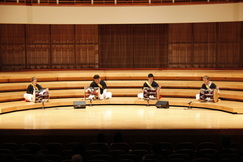
Samdo Sul Changgo Garak
Samdo Sul Changgo Garak highlights the hourglass-shaped drum, the changgo. All players are playing this instrument and are playing rhythms from all three major provincial areas in Korea. Each style is unique and is featured in different movements in the piece. The piece starts with the slow rhythm, gutgeori, and ends with the fast and exciting rhythm, hwimori!
Samdo Sul Changgo Garak highlights the hourglass-shaped drum, the changgo. All players are playing this instrument and are playing rhythms from all three major provincial areas in Korea. Each style is unique and is featured in different movements in the piece. The piece starts with the slow rhythm, gutgeori, and ends with the fast and exciting rhythm, hwimori!
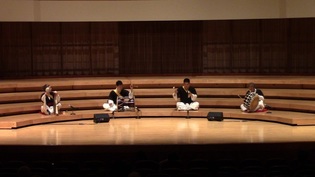
Samdo Nongak Garak
One of the most popular staple repertoire of Samulnori, this piece’s title can be translated as, “Farmers’ Band Rhythms of the Three Provincial Areas.” It showcases the various styles and movements unique to the different types of farmers’ band music from the three major provincial areas in Korea. These various rhythms are performed on all four traditional instruments. The final section features two kkweanggwarri players performing together while interacting with the other instruments.
One of the most popular staple repertoire of Samulnori, this piece’s title can be translated as, “Farmers’ Band Rhythms of the Three Provincial Areas.” It showcases the various styles and movements unique to the different types of farmers’ band music from the three major provincial areas in Korea. These various rhythms are performed on all four traditional instruments. The final section features two kkweanggwarri players performing together while interacting with the other instruments.
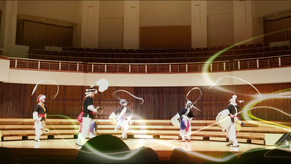
Pan Goot
This piece draws from Samulnori’s origins, farmers’ band music, also known as Nongak. This piece features all performers wearing a special spinning hat called a “sangmo”. In addition, all players play standing up with some instruments strapped to their bodies. While performing, all players dance, play, and spin the sangmo simultaneously. Many different formations are performed together and then the piece is concluded with individual solos of some of the players.
This piece draws from Samulnori’s origins, farmers’ band music, also known as Nongak. This piece features all performers wearing a special spinning hat called a “sangmo”. In addition, all players play standing up with some instruments strapped to their bodies. While performing, all players dance, play, and spin the sangmo simultaneously. Many different formations are performed together and then the piece is concluded with individual solos of some of the players.
Washington Samulnori Members
Sebastian Wang, Executive Director
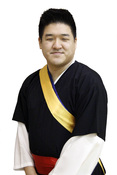
Sebastian Wang was born in Washington, D.C. and has lived in Maryland most of his life. He encountered Samulnori when he was six years old and started taking private lessons when he was nine. He started to perform with a group when he was 14, performing at various local universities as well as the Kennedy Center. After graduating from high school, he continued his study at The Korea National University of Arts in Seoul, Korea, under renowned Samulnori founder and master, Kim Duk Soo. After graduating from the university, Sebastian returned to the states and began teaching and performing in the local Washington D.C. area.
Sanghyuk Park
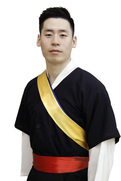
Sanghyuk Park is a traditional Korean percussionist from
Laurel, Maryland. Sanghyuk Park originally studied traditional Korean drumming
and dancing from Jungwoo Lee and Ho-in Choi from Pilbong Nong-ak in 2005 as a
hobby. Sanghyuk Park has performed at numerous events in Washington DC,
Maryland, and Virginia area and has been recognized by the community for his
performances. In 2011, Sanghyuk has begun his professional study in Korean traditional
percussion with Sebastian Wang from Washington Samulnori (WS) and Chunseung Lee
from New York Korean Traditional Marching Band (NYKTMB). As a current member of
WS and NYKTMB, his experience includes performances at Clarice Smith Performing
Arts Center at University of Maryland in 2011-2014 and various cultural events
in the Washington DC area. Sanghyuk Park also teaches members of local
community on weekly basis and hopes to continue to pursue his professional
music career in Korean traditional percussion.
Robin Ghertner
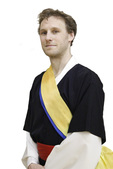
Robin Ghertner has been performing and studying percussion traditions from around the world for over 20 years, including across the US, Korea, Cuba, and Peru. He has his degree in Music Performance and Ethnomusicology from Wesleyan University. Robin has been playing Samulnori and pungmul for the past 12 years, working with the primary pungmul ensemble in New York City between 2004 and 2008. Apart from playing Korean music, he studied composition and percussion under too many masters to name, including Anthony Braxton Pheeroan akLaff, Alfredo Valiente, and Poncho Quinto.
former Members
HyunSeop Lee
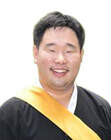
Hyun-Seop Lee started playing traditional Korean percussion instruments when he was 16. He was a member of the youth Pungmul team of the city of Gwacheon, South Korea for two years and learned Utdari Pungmul from director Yongtae Park. Hyun-Seop has been a volunteer at a program that taught students in local communities to play these instruments. He has also played with the Hansori, a Samulnori group in California, Irvine. He became a member of the Washington Samulnori in 2015.
Shelby Kimmel
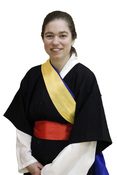
Shelby Kimmel started playing
traditional Korean percussion six years ago when living in South
Korea, and fell in love with the energy and the rhythms of the music. She has
played with Oori, a Samulnori group based at MIT, Cambridge, MA, and with Washington
Samulnori. She has also studied Udo and Pilbong pungmul in Korea. When not
drumming, Shelby researches quantum computing as a postdoctoral fellow at the
University of Maryland.